Don Christobal Colon, known in English as Christopher Columbus, has become one of the most controversial of individuals in World History. In August 1492, Columbus and his crews aboard the Pinta, Niña, and Santa Maria departed from Spain for the Indies.1 However, few know what Columbus observed firsthand when he arrived at the first islands he came across. The only thing was, he didn’t know exactly where he was going, and also didn’t know where he ultimately ended up. In an attempt to report his findings to Queen Isabella, Columbus decided to keep a diary from the day of his departure to the time of his return to Spain.2
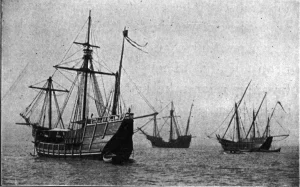
Late in the day on October 11, 1492, the three ships finally arrived to shore, with some hesitation on where to dock because of the unknown area. The Pinta was believed by Columbus to be the “better sailor” of the three ships. The Pinta was the first to find land. The Admiral on the Santa Maria was paying attention closely to where the Pinta was headed. Columbus wrote about this in his diary:
“A sailor named Rodrigo de Triana saw this land first, although the Admiral, at the tenth hour of the night, while he was on the sterncastle, saw a light, although it was something so faint that he did not wish to affirm it was land. But he called Pero Gutierrez, the steward of the king’s dais, and told him that there seemed to be a light, and for him to look: and thus he did and saw it.”3
Well past early morning on Friday, October 12, 1492, Columbus and his crew began to explore the land they had just come upon. The curiosity of this land among him and his fellow sailors began to grow, as it was clear that the land was different from Spain. Of this first contact, Columbus wrote in his diary:
“When they reached an islet of the Lucayas, which was called Guanahani in the language of the Indians. Soon they saw naked people; and the Admiral went ashore in the armed launch, and Martin Alonso Pinzon and his brother Vicente Anes, who was the captain of the Niña. The Admiral brought out the royal banner and the captain’s two flags with the green cross, which the Admiral carried on all ships as a standard, with an F and a Y and over each letter a crown, one on one side and the [Depiction of a Cross] and the other on the other.”4
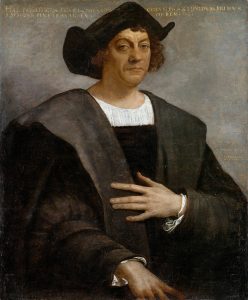
Columbus and his crew began to encounter people living on the land. Columbus constantly referred to these people as “Indians” in his diary. In the original Spanish version, he says “yndios,” which is a direct translation to ‘Indians’ in English.5 The people he encountered often intrigued Columbus, because of their traditions and actions. One thing he assumed while trying to converse with them is that they didn’t have any organized religion. Columbus was an avid Christian, and wrote many excerpts in his diary beginning with prayers and dedications to Christ. His goal wasn’t to convert them, but if he were to convert them because he didn’t know what they believed, he wrote that force wasn’t the option: “Because I recognized that they were people who would be better freed [from error] and converted to our Holy Faith by love than by force…”6 These people were also very familiar with trade, and Columbus engaged with them in trade a couple of times. He would give them things like glass beads, which the Indians put on their chests. They often swam to bring Columbus and his crew cotton, parrots, and more. Columbus summed up his trade experience by writing, “They took everything and gave of what they had very willingly.”7 Columbus planned on leaving with six of the Indians, to give them to the Queen, so he could help them “learn to speak,” as he wrote. Columbus did not encounter any other animals on this island, besides the parrots that were traded.
Columbus did not write an entry on October 12, 1492 for unknown reasons. However, his entry on October 13, 1492 is one of his longest in the entire diary. Early in the morning on the thirteenth, Columbus saw a lot of younger people near the ship, which he described as “handsome,” and that their eye colors resembled some of the Canary Islanders he had encountered:
“All alike have very straight legs and no belly but are very well formed. They came to the ship with dugouts that are made from the trunk of one tree, like a long boat, and all of one piece, and worked marvelously in the fashion of the land, and so big that in some of them 40 and 45 men came. And others smaller, down to some in which came one man alone. They row with a paddle like that of a baker and go marvelously. And if it capsizes on them they then throw themselves in the water, and they right and empty it with calabashes that they carry.”8
Again, the Indians would bring cotton and parrots to trade, which were the only two of the items he listed. By this time, Columbus was curious to find out if there was any gold on the land. He does mention in his writing that it would be “tiresome” to jot down every trade that went on, and what specific items would be traded. Being attentive and catching onto specific details, he was able to comprehend that there was likely some gold in the south from where they currently were located. He wanted to search, but his other crew members had no pure intention of searching with him. Now, Columbus was curious about gold being present on the islands, which almost became a sub-assignment that he kept in the back of his mind for the remainder of his stay.9
A few days later, on October 16, Columbus sailed east for a large island he called Fernandina. He arrived well into the night, because he says he was unable to see the shore to dock the anchor:
“And so I lay to all this night until day, when I came to a village where I anchored and to which had come that man whom I found mid-sea yesterday in that dugout. He had given so many good reports about us that during the whole night there was no lack of dugouts alongside the ship, to which they brought us water and of what they had. I ordered something given to each one, that is to say ten or twelve little glass beads on a thread, and some brass jingles of a sort that in Castile are worth a maravedi each, and some metal lace-ends, all of which they considered of the greatest excellence.”10
The native peoples in this area also exchanged food with the crew, and the natives showed them where to find water, and they even filled barrels for them.11
On that same day, Columbus was again in the hunt for gold. This time, he had a better understanding of where it might be. Some of the Indians told him it was Samoet, which Columbus assumed had to be a city or island not too far from Fernandina: “I set sail with a south wind to strive to go around the whole island and to keep trying until I find Samoet… for so say all these men who come here in the ship, and so told us the men of the island of San Salvador and of Santa Maria.”12 Columbus would eventually get sidetracked with the area and people surrounding him on the land. He writes about the land being green and fertile, as well as many trees that were very different from the ones in Spain: “And in this island I even saw cotton cloths made like small cloaks, and the people are more intelligent, and the women wear in front of their bodies a little thing of cotton that scarcely covers their genitals.”13
At midday on October 17, 1492, Columbus left the current village he was at to sail once more, and search for Samoet. Pinta’s Captain, Martin Alonso Pinzon, told Columbus he got information from some of the Indians on the island, saying going north and then northwest was a simple trick to getting there faster. Nearby, he sent the crew with barrels and weapons to get water. A group of Indians directed them to where there was water near the village. It was quite a walk, and Columbus had written that he took a walk around the area while they were completing their task:
“I stopped for a period of two hours and in this time I also walked among those trees, which were more beautiful to see than any other thing that has ever been seen, seeing as much verdure and in such degree as in the month of May in Andalusia… All of the people are the same as the others already mentioned—of the same qualities and likewise naked and of the same stature—and they gave what they had for anything the men gave them. And here I saw that some ships’ boys traded a few small pieces of broken pottery and glass for javelins. And the others who went for the water told me how they had been in their houses and that inside they were well swept and clean and that their beds and furnishings were made of things like cotton nets. The houses are all made like Moorish campaign tents, very high and with good smoke holes, but I did not see among the many villages that I saw any that surpassed 12 to 15 houses.”14
Columbus did find his way to Samoet a few days later, on Saturday, October 20. He named the cape Cabo de la Laguna, and the island, he named Isabela. By Sunday the 21st, he had found he was in Cabo del Isleo. By later that evening into Monday the 22nd, he had made his way to Cipango, or Colba, as the Indians called it. He stayed waiting to see if anyone from this part of the land would come and ask for a trade. They did, and came in bunches like previously. Columbus had seen they traded things like broken glass and pottery for glass beads, and that like others, they wore gold rings on their noses. Trade seemed to be a huge practice among them, as Columbus wrote. By Tuesday the 23rd, he had got ready to sail for the Island of Cuba. Columbus thought it was the same as Cipango because of the descriptions and indications he received from people on the other islands. He couldn’t begin sailing, however, because of heavy rain and no wind. He was able to sail on Wednesday the 24th, even though it was still windy. Even having found a chain of islands where they landed near Fernandina, it took until the 28th for him to get there, because of the weather and the need to stop sailing. The island seemed empty, and there were houses with fisher’s equipment. However, an interesting find for Columbus was that these people in Cuba seemed to have an organized religion, but it was unclear to him. He assumed this because there were statues of women on the island and he didn’t know what they were exactly for.15
Everywhere they went, trends in people and land were consistent. They departed back to Spain in January of 1493, and on March 15, the Admiral got a little recognition for his work by the Spanish Royalty as well, as the ships went to Barcelona to see the Queen and King.
Columbus finished his diary and journey by writing, “I hope in Our Lord that it will be the greatest honor to Christianity that, unexpectedly, has ever come about. These are the final words of Admiral Don Christobal Colon concerning his first voyage to the Indies and their discovery. Thanks be to God.”16
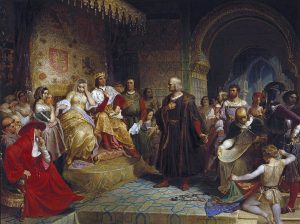
- Oliver Dunn, James E. Kelley, Jr, The Diario of Christopher Columbus’s First Voyage to America 1492-1493, 1st Edition, University of Oklahoma Press: Norman and London, 1989. 65. ↵
- David L. Bender, Bruno Leone, and Mary Ellen Jones, Christopher Columbus and His Legacy: Opposing Viewpoints, 1st Edition, (Greenhaven Press Inc., 1992), 11. ↵
- Oliver Dunn, James E. Kelley, Jr, The Diario of Christopher Columbus’s First Voyage to America 1492-1493, 1st Edition, (University of Oklahoma Press: Norman and London, 1989), 59. ↵
- Oliver Dunn, James E. Kelley, Jr, The Diario of Christopher Columbus’s First Voyage to America 1492-1493, 1st Edition (University of Oklahoma Press: Norman and London, 1989), 63. ↵
- Oliver Dunn, James E. Kelley, Jr, The Diario of Christopher Columbus’s First Voyage to America 1492-1493, 1st Edition, (University of Oklahoma Press: Norman and London, 1989), 63. ↵
- Oliver Dunn, James E. Kelley, Jr, The Diario of Christopher Columbus’s First Voyage to America 1492-1493, 1st Edition (University of Oklahoma Press: Norman and London, 1989), 65. ↵
- Oliver Dunn, James E. Kelley, Jr, The Diario of Christopher Columbus’s First Voyage to America 1492-1493, 1st Edition (University of Oklahoma Press: Norman and London, 1989), 65. ↵
- Oliver Dunn, James E. Kelley, Jr, The Diario of Christopher Columbus’s First Voyage to America 1492-1493, 1st Edition, (University of Oklahoma Press: Norman and London, 1989), 69. ↵
- Oliver Dunn, James E. Kelley, Jr, The Diario of Christopher Columbus’s First Voyage to America 1492-1493, 1st Edition, (University of Oklahoma Press: Norman and London, 1989), 71. ↵
- Oliver Dunn, James E. Kelley, Jr, The Diario of Christopher Columbus’s First Voyage to America 1492-1493, 1st Edition, (University of Oklahoma Press: Norman and London, 1989), 87. ↵
- Oliver Dunn, James E. Kelley, Jr, The Diario of Christopher Columbus’s First Voyage to America 1492-1493, 1st Edition, (University of Oklahoma Press: Norman and London, 1989), 87. ↵
- Oliver Dunn, James E. Kelley, Jr, The Diario of Christopher Columbus’s First Voyage to America 1492-1493, 1st Edition, (University of Oklahoma Press: Norman and London, 1989), 87, 88. ↵
- Oliver Dunn, James E. Kelley, Jr, The Diario of Christopher Columbus’s First Voyage to America 1492-1493, 1st Edition, (University of Oklahoma Press: Norman and London, 1989), 89. ↵
- Oliver Dunn, James E. Kelley, Jr, The Diario of Christopher Columbus’s First Voyage to America 1492-1493, 1st Edition, (University of Oklahoma Press: Norman and London, 1989), 93. ↵
- Oliver Dunn, James E. Kelley, Jr, The Diario of Christopher Columbus’s First Voyage to America 1492-1493, 1st Edition, (University of Oklahoma Press: Norman and London, 1989), 111-119. ↵
- Oliver Dunn, James E. Kelley, Jr, The Diario of Christopher Columbus’s First Voyage to America 1492-1493, 1st Edition, (University of Oklahoma Press: Norman and London, 1989), 403. ↵
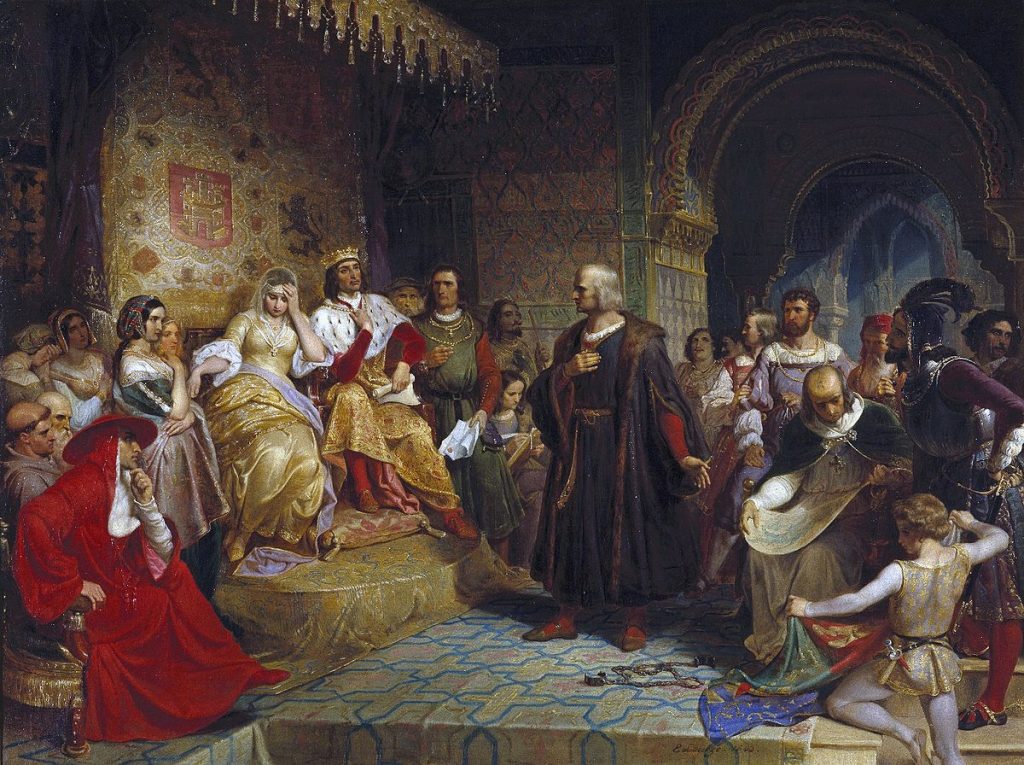


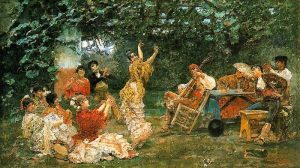
23 comments
Kayla Braxton-Young
The information in this article about some of the things that happened during the colonization of the Americas was very interesting. Numerous writings on Christopher Columbus have been read, but hearing a different perspective on the man himself is always interesting. I believe that our nation’s history deserves more attention and that it is something that is frequently overlooked. I’ve done a lot of reading and learned a lot about Christopher Columbus. My interest in reading this essay was piqued by the appealing images. You completed excellent research. It sparked my interest in Christopher Columbus and his writings.
Grace Ibarra
I really liked how you included excerpts from Christopher Columbus’ diary. I feel like that really helped you bring this story and this research to life. It was also interesting to learn Christopher’s real name; I had never heard it in Spanish even though he is from Spain. Overall, this was a great article; very informative!
Franchesca Tinacba
I think you did an awesome job with this article! I mean I knew a lot about Christopher Columbus, but I never truly knew too much about the personal things such as his journals/writings. I feel like this is something that can help readers really understand what Columbus was thinking and what his perspective of the world was like. Congratulations on your article and publication!
Jocelyn Elias
Congratulations on your nomination Esteban. I have no idea there was like such a big controversy over Christopher Columbus and I also had no idea of his original name. I don’t really read into early American studies so this was a really interesting topic to read about. I really like a lot of your sources I think they support your argument thoroughly.
Eugenio Gonzalez
First of all, congratulations on your publication and nomination. It is interesting to see how Christopher Columbus narrates his experiences during his journey. It was also interesting to see how Christopher Columbus saw Native Americans. The author does an excellent job of using good-quality images that keep the readers interested in the interactions between Christopher Columbus and the Natives Americans.
Dylan Vargas
The controversy within Columbas is something that I personally don’t find very important. I mean it was in the past and we live now but that doesn’t mean I don’t like the article. It’s not one-sided and also gives us information on the controversy and why it is, to begin with. Also giving us the history of Columbus and America.
Vanessa Preciado
Nicely done ! I like how you displayed his birth name, as a lot of us know him only as Christopher Colombus. I enjoyed reading this, I learned about him in history class, but this article talks more about his situation in detail. Very well written and the images are nice!
Courtney Mcclellan
Congratulations on your publication and nomination. This article was really informative. I never knew that Columbus had a diary and that he documented everything. The way Columbus viewed the natives in his journal was different from what i had constantly heard. The complexity of the natives city and trade systems is really incredible to hear about from someone who was there.
Sudura Zakir
This article was fabulous to read because of highlighting some events of colonization of America. About Christopher Columbus, I have read a lot and learned many things. I liked the pictures which drew my attention for reading this article. You did great research work. It made me more curious about Columbus and his writings. I want to hear more from your article next time.
Ben Kruck
i know its late, but congratulations on getting your article published. I think this is a well written and informative article. I actually didn’t know there was controversy surrounding Christopher Columbus, but it didn’t stop me from reading. It’s so interesting that Chirstopher Columbus was curious and amazed about everything he saw. I also like how you cited Christopher Columbus’ journal as a source.